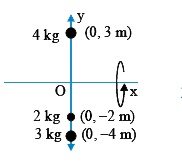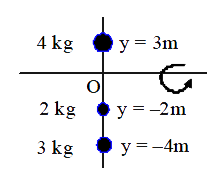A light bulb shines light along the x axis and through two parallel ideal polarizing filters one with a fixed polarizing axis and the other with an axis that rotates about the x axis and the yz plane . Looking toward the light bulb through the combined filtering system you see
A bulb almost disappearing twice per revolution and reaching a maximum intensity twice per revolution . The maximum brightness is not as bright as looking at an unfiltered bulb
As in (a) but once per revolution
As in (a) but with a maximum brightness as bright as an unfiltered bulb
As in (a) but with a bulb that disappears completely
The correct Answer is:A
Topper's Solved these Questions
- BOOK - RESNICK AND HALLIDAYCHAPTER - ELECTROMAGNETIC WAVES EXERCISE - PRACTICE QUESTIONS (More than One Correct Choice Type )4videos
ELECTROMAGNETIC WAVES
- BOOK - RESNICK AND HALLIDAYCHAPTER - ELECTROMAGNETIC WAVES EXERCISE - PRACTICE QUESTIONS (Linked Comprehension)2videos
ELECTROMAGNETIC WAVES
- BOOK - RESNICK AND HALLIDAYCHAPTER - ELECTROMAGNETIC WAVES EXERCISE - PROBLEMS29videos
ELECTROMAGNETIC WAVES
- BOOK - RESNICK AND HALLIDAYCHAPTER - ELECTROMAGNETIC OSCILLATIONS AND ALTERNATING CURRENT EXERCISE - Practice Questions (Integer)7videos
ELECTROMAGNETIC OSCILLATIONS AND ALTERNATING CURRENT
- BOOK - RESNICK AND HALLIDAYCHAPTER - FLUIDSEXERCISE - PRACTICE QUESTIONS (Integer Type )5videos
FLUIDS
Similar Questions
When a given light beam is passed through a polaroid and polaoid is rotated about the incident light axis, what are the three possiblities ?
View SolutionAn unpolarized light is travelling along Z axis through three polarizing sheets. The polarzing direction of the first and third sheet are respectively parallel to X axis and Y axis whereas that of the second one is at 60∘ to the Y axis. Then, the fraction of the initial light intensity that emerges from the system in about,
View Solution
Knowledge Check
- Question 1 - Select One
An unpolarized light is travelling along Z axis through three polarizing sheets. The polarzing direction of the first and third sheet are respectively parallel to X axis and Y axis whereas that of the second one is at 60∘ to the Y axis. Then, the fraction of the initial light intensity that emerges from the system in about,
AzeroB3I032CI032D9I032 - Question 2 - Select One
Unpolarized light of intensity I0 is incident on a polarizer and the emerging light strikes a second polarizing filter with its axis at 450 to that of the first . The intensity of the emerging beam
AI02BI04CI0DI03 - Question 3 - Select One
Unpolarized light of intensity I0is incident on a polarizer and the emerging light strikes a second polarizing filter with its axis at 45∘ to that of the first. The intensity of the emerging beam
AI02BI04CI0DI03
Three particles are situated on a light and rigid rod placed along Y-axis. If the system rotates about X-axis, the M.I. of the system is :
 View Solution
View SolutionThree particles are situated on a light and rigid rod placed along Y-axis. If the system rotates about X-axis, the M.I. of the system is :
 View Solution
View SolutionThree particles are connected by light, right rods lying along the y-axis. If the system rotates about the x-axis with an angular speed of 2 rad/s, the M.I. of the system is
 View Solution
View SolutionUnpolarized light of intensity I0 is incident on a series of three polarizing filters. The axis of the second filter is oriented at 45∘ to that of the first filter, while the axis of the third filter is oriented at 90∘ to that of the first filter. The intensity of the light transmitted through the third filter is I0n. Find n.
View SolutionUnpolarized light passes through two polaroids, the axis of one is vertical and that of the other is 30∘ to the vertical . What is the orientation and intensity of the transmitted light ?
View Solution

